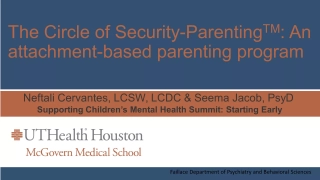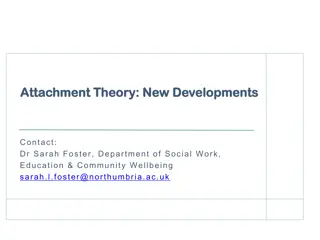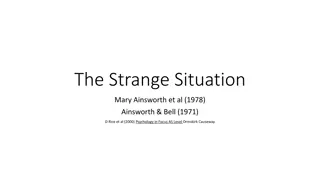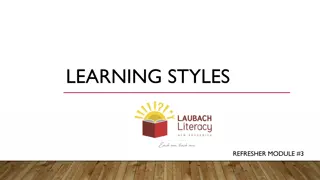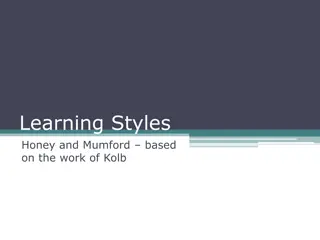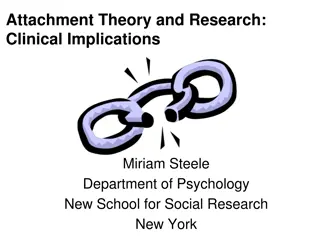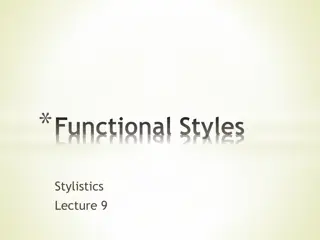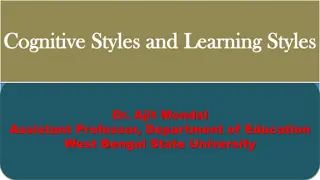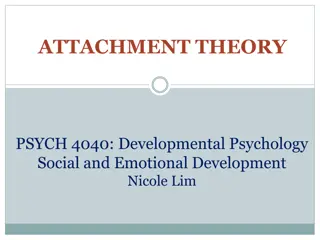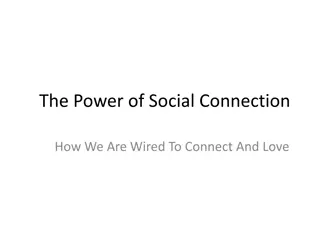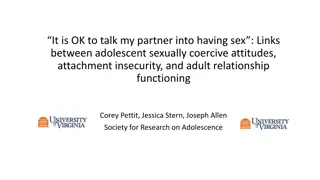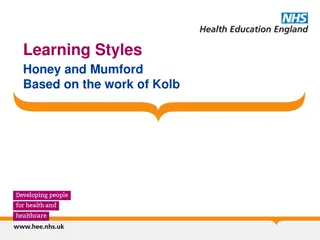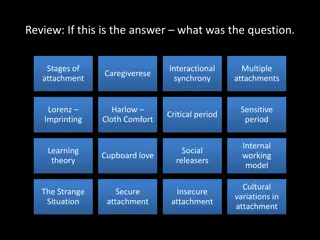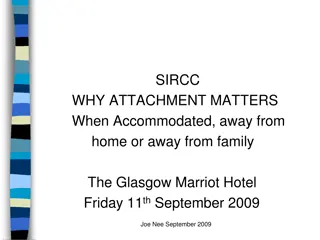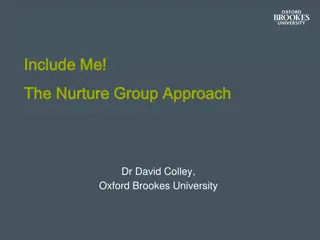Understanding Love Styles in Relationships Based on Attachment Theory
Early life experiences play a crucial role in shaping how we love in relationships. Milan and Kay Yerkovich have developed tools rooted in attachment theory to help individuals understand and improve their love styles. People tend to fall into five categories of Love Styles, such as the Avoider, who may struggle with emotional intimacy due to childhood experiences. By recognizing and addressing these patterns, individuals can enhance their relationships and deepen their connection with their partners. Explore more at howwelove.com.
Download Presentation

Please find below an Image/Link to download the presentation.
The content on the website is provided AS IS for your information and personal use only. It may not be sold, licensed, or shared on other websites without obtaining consent from the author. Download presentation by click this link. If you encounter any issues during the download, it is possible that the publisher has removed the file from their server.
E N D
Presentation Transcript
How we Love The dances we do in our relationships. The origins? https://howwelove.com/
Introduction Our early life experiences, for better or worse, teach us how to love. Having the same arguments all the time and seeing the same patterns every time with no idea why we are there again makes people believe that there is a problem that is unfixable Milan and Kay Yerkovich have created the tools to take your relationships to the next level based on the attachment theory Each person s childhood experiences form the roots of who they are; continuing to inform the way that person responds to others or expresses love, even far into adulthood The result of all these experiences are actually very predictable because people tend to fall into one of five special categories: called Love Styles
Avoider I am usually fine, and when something bad happens I try to get over it quickly In my family growing up, we rarely discussed personal concerns I m usually happiest when others are happy and don t want a lot from me I don t really think about my own feelings and needs very often I don t really miss my spouse or family if I m away from them I need my space
Avoider Coming from homes that are often low in affection, but which place high value on independence and self- reliance The Avoider grows up learning only to take care of themselves. To deal with the anxiety of having so little comfort and nurturing from their parents, they have learned to restrict their feelings and suppress their needs. As an adult, Avoiders can seem emotionally distant or unengaged
Avoider Connecting with Others: Task Orientated. Minimum Emotions Independent and deals swiftly with problems moves on quickly Conflict: Cause emotions Do not like to deal with emotions Gets irritated with the other party getting too needy Avoider closes down like a book
Image result for disappointed boy Avoids emotion and needs of self and others Child s feelings Developing Avoiders Child learns to restrict emotions and becomes independent Child s needs overwhelming to parent Parent encourage limited expression no comfort Child s Expression stifled or limited by parent
Pleaser For most (or all) of my childhood I could have been described as the good kid I feel very upset if someone is upset or annoyed with me so I am good at keeping peace I seek connection and avoid rejection by anticipating and meeting others needs Conflict makes me uneasy and I prefer to deal with disagreement by giving in or making up for it and quickly and moving on I have difficulty confronting or saying no and sometimes it makes me less than truthful
Pleaser Pleasers usually grow up in a home with a parent who is overly protective, angry, and/or critical Pleaser children do everything they can to be good and avoid troubling their highly-reactive parent; they learn to spend their energy comforting or appeasing their parent, instead of receiving comfort themselves As adults, Pleasers tend to continually monitor the moods of those around them in an attempt to keep everyone happy. However, this can lead to resentment, an emotion that can break down a relationship or drive a Pleaser to leave.
Pleaser Connecting with Others: Being nice so others will stay close Avoiding conflict Minimizing or downplaying problems Feeling a need to fix the negative emotions of others Conflict: Collude to ignore the realities of pain, problems, and difficult emotions. Be dishonest to avoid conflict Reassure rather than listen! Avoid reality and tries to stay over-optimistic (things will soon be OK again )
Avoids emotion and needs of self and others Child s feelings Developing Pleasers Child Child s needs cause fear & anxiety to parent / parent critical develops fear, anxiety, worry and clinginess / performance anxiety Parents overprotect, worries and smothers / Parents critical, high expectations Causes internal and external parental alarms / parent overly critical
Vaccilator I feel like no one has really understood what I need I experience internal conflict and a high level of emotional stress in relationships At times, I find myself picking a fight and I m not sure why I ve always been especially sensitive and perceptive and can tell when others are pulling away from me Others have said they feel like they re walking on eggshells around me
Vaccilator Growing up with an unpredictable parent, Vacillators needs aren t top priority Without consistent parental affection they develop feelings of abandonment, and by the time the parent feels like giving again, their child is tired of waiting and too angry to receive As adults, Vacillators are on a quest to find the consistent love they never received as children They idealize new relationships, but then get tired of it once life (and the relationship) gets less than perfect.
Vaccilator Connecting with Others: Idealization, which leads to disappointment Preoccupation with relational closeness/distanceAddressing problems with complaints rather than requests Arrivals/departures, or waiting for the spouse to engage Conflict: Vents or protests to lower anxiety, then moves from idealizing to devaluing The Vacillator is likely to assume their partner s motives are to hurt intentionally Venting by anger fits and strong language
Looking for intense consistent connection Child s feelings Developing Vaccilators Confused and hypervigilant trying to predict and control relationships / angry and anxious Child s needs sometimes ignored and sometimes acknowledged. Focus on parents needs Emotions becomes limited, sporadic dependant on reading the parent s mood Inconsistent and unpredictable the child waits for the parent to connect
Controller No one protected me from harm when I was growing up, so I had to get tough and take care of myself Life has taught me to either be in control or be controlled People would probably describe me as intimidating. I prefer to solve problems on my own I need things to be done a certain way or I get angry I have few feelings about my childhood except I m glad it s over because I wouldn t go back
Controller Controllers need control to ensure that the vulnerable, negative feelings they experienced in childhood remain suppressed from their adult lives Having control means having protection from feelings like fear, humiliation, and helplessness; however, anger is the one emotion that is not vulnerable, and so anger and intimidation are often used as means to maintain control While control can be either highly rigid or sporadic and unpredictable, Controllers rarely realize the true reason they feel the need to be in charge
Controller Connection with Others: Desire for compliance/control create predictability Anger being a defense against painful/vulnerable feelings Desiring control, not connection. Having no empathy for self or others Conflict: Controller builds up anxiety/tension due to Non- compliance. Being rigid, easily angered, and deregulated. Unpredictability is a reminder of childhood trauma
The Personification of The Victim Victim Growing up, I experienced a great deal of intense anger and stress from a parent or parents. I m used to chaos and calm makes me anxious because something bad is always just around the corner. If I spoke up more and had stronger opinions, my spouse (or other significant relationships) would be even angrier. I feel like I m just going through the motions and I m tired and out of energy.
The Personification of The Victim Victim Kids survive a chaotic home environment by trying to stay under the radar , making themselves as invisible as possible They ll hide and appease, learning how to escape into their own heads to lessen the pain from their angry, violent, chaotic parents Victims lack a sense of self-worth or personhood and are often anxious and depressed Rather than engage, they ll resort to just going through the motions in order to get by
The Personification of The Victim Victim Connection to Others Having learned to tolerate the intolerable during childhood, the Victim attempts to placate Victims have little or no voice in the relationship; they are child-like. Conflict: Following the incident , the Victim freezes or disassociates They become depressed and/or detached, and may even threaten to leave
Childs feelings Controller: Developing Controllers / Victims Child s needs disregarded or overwhelming to parent Confused causing anxiety, fear and anger Abuse or Neglect of Child Parent becomes the source of stress for the Child Emotions causes outrage or withdrawal from parent


